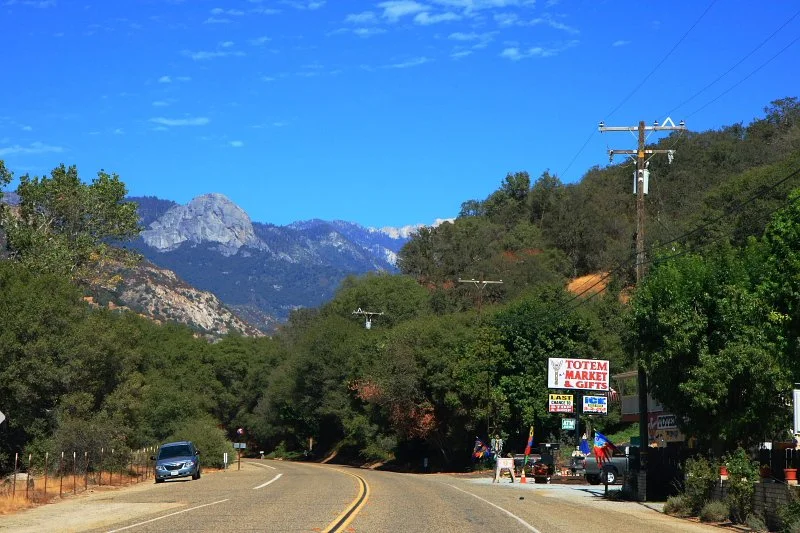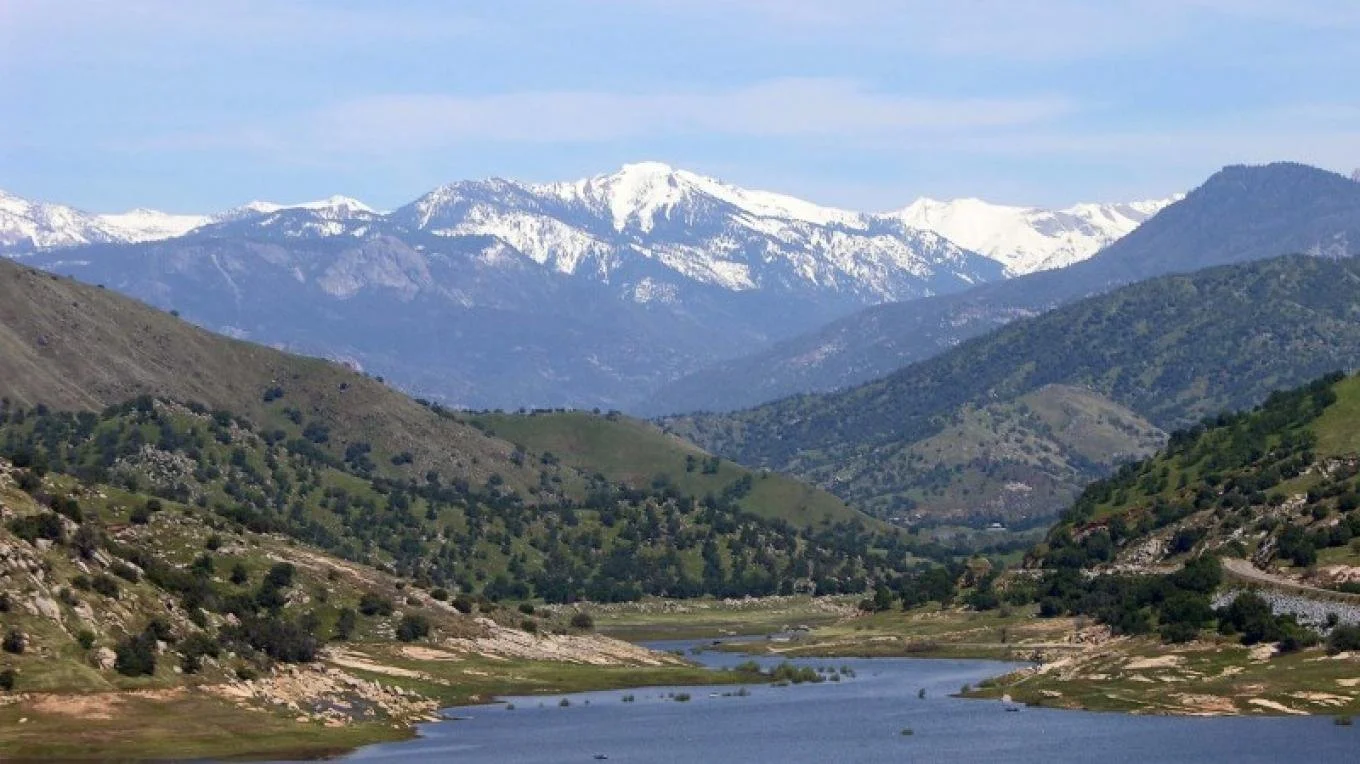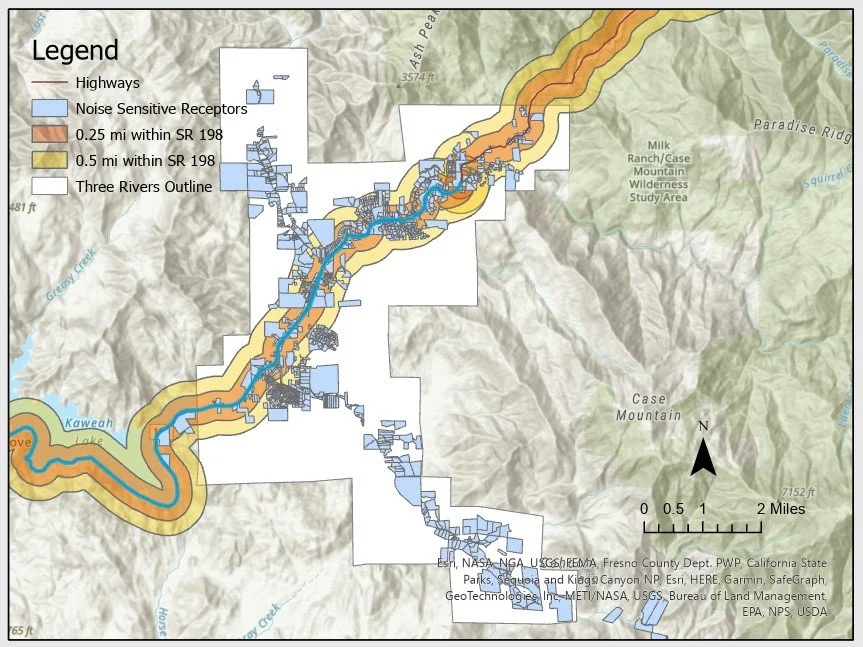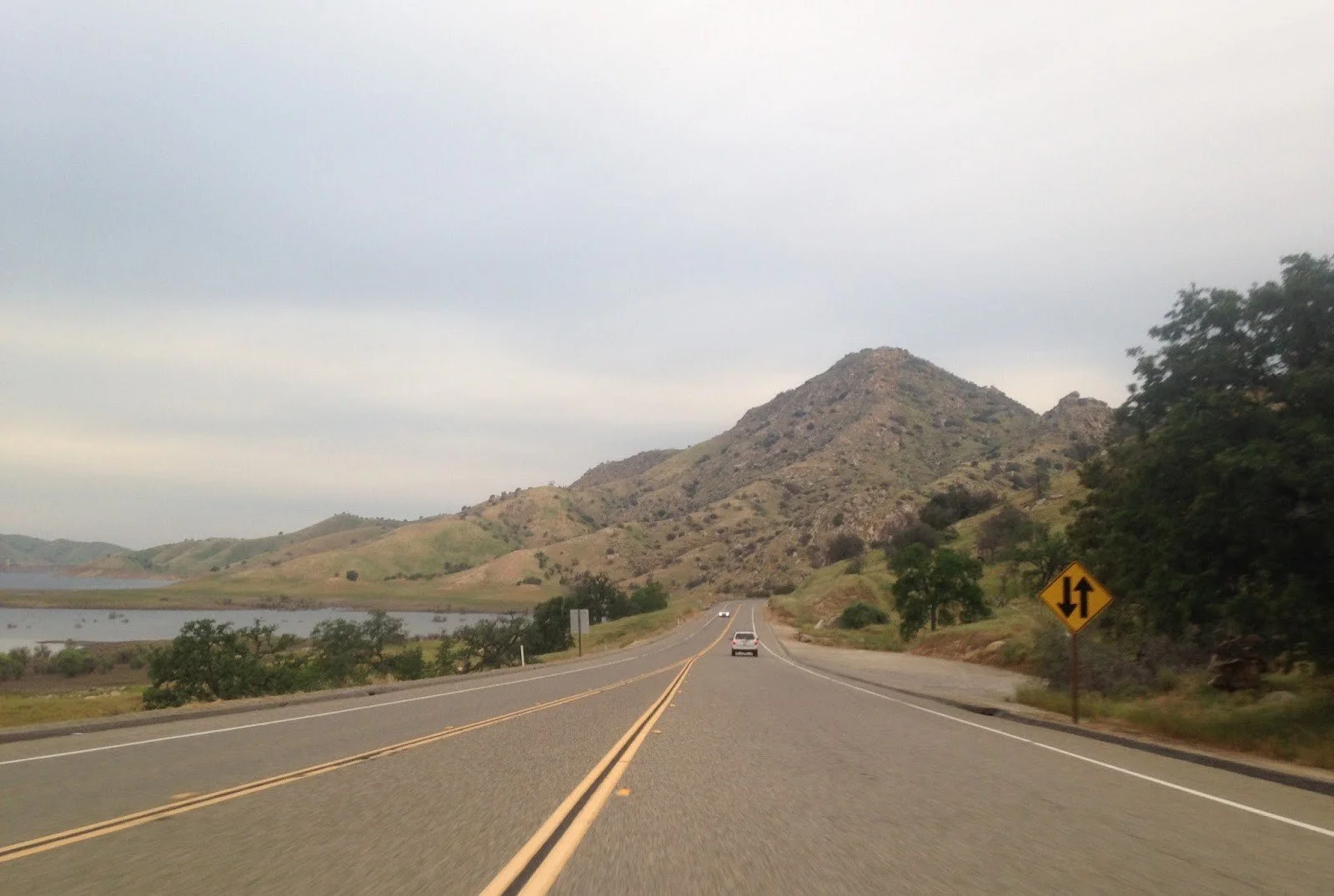Benjamin Chu on the Noise Team
Three Rivers 2018 Community Plan Background and Suggestions
Introduction
This document is a review of the Three Rivers Community Plan 2018 Update, conducted five years after the adoption of the Plan. Fourth-year City and Regional Planning undergraduate students at California Polytechnic State University, San Luis Obispo prepared this Review. This Review can serve Tulare County Resource Management Agency as a tool and reference for further planning in Three Rivers.
The study area is the unincorporated community of Three Rivers in northern Tulare County, California. The study area serves as an entry to Sequoia National Park in Tulare County. The nearest population center is the county seat, Visalia, about 35 miles west of Three Rivers. The primary route linking the study area is State Highway 198, which connects Visalia to the west and ascends into the Sequoias to the east.
Three Rivers is constrained by its topography. The bulk of the community is nestled along the Kaweah River, which weaves through the sloped, foothill geography. The sloped terrain creates sharp drop offs along State Highway 198. Granite is prevalent in the soils, which makes development and infrastructure upgrades difficult.
The population of Three Rivers was about 2,699 residents in 2020 which is a slight increase from the 1,949 residents surveyed in the 2010 American Community Survey, representing a growth rate of about 3 percent annually.
The predominant racial identity in Three Rivers is White, accounting for over 90 percent of its residents. The Asian-identifying population makes up the next largest group of individuals, at 5.9 percent of the community. Black, Asian, or Pacific Islander individuals account for only 2.4 percent of the community. 1.3 percent of the community identifies as two or more racial identities. Approximately 7.5 percent of the population identifies as Hispanic.
Noise
Introduction
The Noise Element ensures a community’s exposure to excessive sound in sensitive land uses and times of day are limited. It identifies major sources of noise, explains the negative impacts of noise, and explores the necessary mitigation measures. While Three Rivers lacks certain major noise sources like air traffic and railroad operations, maintaining minimal noise is essential to the community’s tranquil and peaceful environment.
Existing Goals, Objectives, Policies, and Implementation Measures from the Adopted 2018 Three Rivers Community Plan
Goal 1: Safety. Protect the community of Three Rivers from excessive noise.
Objective 1.1: Identify major sources of noise
Policy 1.1.1: The major source of mobile noise, associated with transportation, in Three Rivers is SR-198 or Sierra Drive.
Policy 1.1.2: The major source of stationary, or fixed, noise in Three Rivers include outdoor machinery, amplified events, and the Kaweah River.
Goal 2: Economic Viability. Separation of Land Uses to prevent conflicting uses.
Objective 2.1: Noise impacted, and sensitive areas should be considered
Policy 2.1.1: Identify Noise Impacted areas as those exceeding 60 decibels or dBa. The decibel was decided given the fact that it is the maximum normally accepted level of noise for single family residential areas. Uses effected by noise can be observed in the map below.
Policy 2.1.2: Commercial and Industrial areas have a higher noise standard (65 dB Ldn 75 dB Ldn, respectively) and, as development occurs, could also include noise attenuating walls and building material insulation to prevent exceedances of these standards.
Policy 2.1.2: If development within the residential reserve area occurs during the planning period, design features such as noise attenuating walls and setback distances can be incorporated into the design of future residential areas along SR 198 to prevent exceedances of the 60 dB Ldn.
Relevant Policies from Tulare County General Plan
HS-8 Goal: Protect the citizens of Tulare County from the harmful effects of exposure to excessive noise.
HS-8.1 Economic Base Protection: The County shall protect its economic base by preventing the encroachment of incompatible land uses on known noise-producing industries, railroads, airports, and other sources.
HS-8.2 Noise Impacted Areas: The County shall designate areas as noise-impacted if exposed to existing or projected noise levels that exceed 60 dB Ldn (or Community Noise Equivalent Level (CNEL)) at the exterior of buildings.
HS-8.3 Noise Sensitive Land Uses: The County shall not approve new noise sensitive uses unless effective mitigation measures are incorporated into the design of such projects to reduce noise levels to 60 dB Ldn (or CNEL) or less within outdoor activity areas and 45 dB Ldn (or CNEL) or less within interior living spaces.
HS-8.5 State Noise Standards: The County shall enforce the State Noise Insulation Standards (California Administrative Code, Title 24) and Chapter 35 of the Uniform Building Code (UBC). Title 24 requires that interior noise levels not exceed 45 dB Ldn (or CNEL) with the windows and doors closed within new developments of multi-family dwellings, condominiums, hotels, or motels. Where it is not possible to reduce exterior noise levels within an acceptable range the County shall require the application of noise reduction technology to reduce interior noise levels to an acceptable level.
HS-8.6 Noise Level Criteria: The County shall ensure noise level criteria applied to land uses other than residential or other noise-sensitive uses are consistent with the recommendations of the California Office of Noise Control (CONC).
HS-9 Goal: Protect the economic base of Tulare County by preventing the encroachment of incompatible land uses near known noise-producing industries, railroads, airports, and other sources.
HS-8.7 Inside Noise: The County shall ensure that in instances where the windows and doors must remain close to achieve the required inside acoustical isolation, mechanical ventilation or air conditioning is provided.
HS-8.8 Adjacent Uses: The County shall not permit development of new industrial, commercial, or other noise- generating land uses if resulting noise levels will exceed 60 dB Ldn (or CNEL) at the boundary of areas designated and zoned for residential or other noise-sensitive uses, unless it is determined to be necessary to promote the public health, safety, and welfare of the County.
HS-8.9 County Equipment: The County shall strive to purchase equipment that complies with noise level performance standards set forth in the Health and Safety Element.
HS-8.10 Automobile Noise Enforcement: The County shall encourage the CHP, Sheriff's office, and local police departments to actively enforce existing sections of the California Vehicle Code relating to adequate vehicle mufflers, modified exhaust systems, and other amplified noise.
HS-8.11 Peak Noise Generators: The County shall limit noise generating activities, such as construction, to hours of normal business operation (7 a.m. to 7 p.m.). No peak noise generating activities shall be allowed to occur outside of normal business hours without County approval.
HS-8.12 Foothill and Mountain Noise: For areas designated by Tulare County as being within Foothill and Mountain Planning Areas and outside Foothill Development Corridors, the hourly Leq resulting from the development or new noise-sensitive land uses or new noise-generating sources shall not exceed 50 dB during the day (7:00 a.m.-10:00 p.m.) or 40 dB during the night (10:00 p.m.- 7:00 a.m.) when measured at the boundary of areas containing or planned and zoned for residential or other noise-sensitive land uses. For these same areas and under the same circumstances, the maximum A-weighed noise level (Lmax) shall not exceed 70 dB during the day or 60 dB during the night.
HS-8.13 Noise Analysis: The County shall require a detailed noise impact analysis in areas where current or future exterior noise levels from transportation or stationary sources have the potential to exceed the adopted noise policies of the Health and Safety Element, where there is development of new noise sensitive land uses or the development of potential noise generating land uses near existing sensitive land uses. The noise analysis shall be the responsibility of the project applicant and be prepared by a qualified acoustical engineer (i.e., a Registered Professional Engineer in the State of California, etc.). The analysis shall include recommendations and evidence to establish mitigation that will reduce noise exposure to acceptable levels (such as those referenced in Table 10-1 of the Health and Safety Element).
HS-8.14 Sound Attenuation Features: The County shall require sound attenuation features such as walls, beaming, heavy landscaping, between commercial, industrial, and residential uses to reduce noise and vibration impacts.
Recommendations
Currently the Community Plan displays appropriate levels of noise for each land use, the major sources of noise, and measures in case new development occurs. However, the existing plan fails to elaborate on the potentially negative impacts of noise. A lack of readily available information to the public may cause detrimental effects to individual health if precautions or indicated warnings were not established. In addition to the prior, the lack of a given warning reduces the significance and undermines the potential impact of noise.
The Three Rivers Community Plan does not explicitly classify vacation rentals or gathering venues as a major source of noise. According to the Community Plan and residential input, State Highway 198 had been identified as the sole major source of noise. However, community response has deemed the rentals as nuisances due to the amount of noise exuded when meetings or gatherings occur. They often exceed acceptable levels of noise for residential or noise sensitive areas. Along with the disregard for the sensitivity of land use, such gatherings often exceed noise thresholds during sensitive times of the day, further disrupting the presumed quietness associated with natural space. The community plan fails to properly weigh the CNEL. It is recommended that such uses should be classified as major sources of noise for the respect of the affected community.
Recommendations for the Noise Element include the following.
Classification of vacation rentals and gathering venues as a major source of noise, allowing for differing standards and additional separation of uses HS-8.8. Along with the classification, additional measures should be prompted to ensure compliance:
Noise Ordinance that emphasizes the sensitivity of the time of day, which is reflective of HS-8.11.
Enforcement, in which sheriff intervention should exceed automobile noise as shown in HS-8.10.
Introduction of noise mitigating design such as triple paned windows.
State the potential impacts of excessive noise in the community plan which would include:
Stress related illnesses, high blood pressure, speech interference, hearing loss, sleep disruption, and lost productivity.
Measures to curb the noise from prior major sources: SR 198
Multi modal transportation network.
The reduction of the speed limit through the community.
Implementation of triple paned windows for developments along State Route 198.







